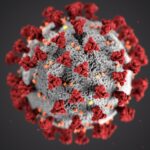
The SARS-CoV-2 virus is responsible for the Coronavirus Disease-2019 (COVID-19) Global Pandemic (Dental Elf – 3rd July 2020). Research has shown that SARS-CoV-2 invades human cells via the receptor angiotensin-converting enzyme 2 (ACE2) which is located in salivary glands and the tongue. The oral signs and symptoms related to COVID-19 are of particular interest for oral healthcare providers.
The aim of this review was to summarise the oral signs and symptoms in patients with COVID-19.
Methods
The Preferred Reporting Items for Systematic Review and Meta-Analyses (PRISMA) were used to inform the methodology of this living systematic review. The review’s data is planned to be updated every 6 months over the next 2 years through a re-search every 5 months. Embase, Web of Science, LILACS, PubMed, Livivo and Scopus were the databases searched. Additionally, the grey literature was searched including Google Scholar and OpenGrey along with reference lists of included studies. All articles published until 6th June 2020 that investigated the prevalence of oral disorders in patients with COVID-19 were included. The Joanna Briggs Institute’s Critical Appraisal Checklist for Studies Reporting Prevalence Data and the Critical Appraisal Checklist for Case Reports were used to assess risk of bias. The GRADE instrument was used to assess the evidence quality.
Results
- 40 studies (33 cross-sectional and 7 case reports) were included.
- Smell dysfunction was extensively reported in studies assessing taste disorders with its prevalence ranging from 4.9%-69.8% in patients with COVID-19.
- At least 14 studies reported a higher prevalence of taste disorders in comparison with smell dysfunction.
- 7 case reports described oral lesions. These included blisters, white plaques, ulcers, erythematous patches and desquamative gingivitis. Four patients presented with localised oral mucosal lesions whereas 3 patients had diffuse lesions. The tongue mucosa was the most commonly affected area (in 5 patients). In 2 patients, oral manifestations developed in association with initial systemic symptoms of COVID-19. Those patients with severe COVID-19 (requiring medication or hospitalisation) developed lesions between the 7th-24th day after symptom onset.
- The certainty of evidence from outcomes assessed by the GRADE system was high for the prevalence of taste disorders and COVID-19 positivity, severity and patient sex. A low certainty of evidence was observed regarding the descriptive oral mucosal lesions.
- Regarding taste disorders;
- the prevalence of dysgeusia (altered taste) was 38% (95% CI, 22-56%, I2=98%),
- 35% for hypogeusia (reduced ability to taste) (95% CI, 21-51%, I2=97%) and
- 24% for ageusia (complete loss of taste) (95% CI, 15-35%; I2=97%).
- The mean duration of symptoms was 15 days and patients were reported to fully recover.
- The OR analysis showed a positive association between taste disorder symptoms and COVID-19 (OR 12.68 (95% CI, 6.41-25.10; I2=63%; P<0.00001)).
- There was an association between mild/moderate COVID-19 cases (as compared with severe cases) and taste disorders (OR 2.09 (95% CI, 1.25-3.49; I2=66%; P=0.005)).
- Taste disorders were also significantly associated with female patients (OR 1.64 (95% CI, 1.23-2.17; I2=70%; P=0.0007).
Conclusions
The authors concluded: –
…With a moderate certainty of evidence… taste disorders are associated with COVID-19 positivity, mild/moderate severity and female sex. There is a low certainty of evidence regarding oral mucosal lesions in patients with COVID-19…
Comments
This living systematic review and meta-analysis showed a significant association between taste disorder symptoms and COVID-19, particularly with mild/moderate cases compared to severe cases. The evidence for oral mucosal lesions as a manifestation of COVID-19 was uncertain. This living review is well planned with evidence quality assessment and a robust structure in place to re-assess the literature.It will be interesting to follow any changes that emerge over time.
References
Primary reference
Amorim Dos Santos J, Normando AGC, Carvalho da Silva RL, Acevedo AC, De Luca Canto G, Sugaya N, Santos-Silva AR, Guerra ENS. Oral Manifestations in Patients with COVID-19: A Living Systematic Review. J Dent Res. 2021 Feb;100(2):141-154. doi: 10.1177/0022034520957289.
Other references
Dental Elf – 3rd July 2020
Association or causation? How do we ever know? – From The Catalogue of Bias
Photo Credits
